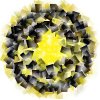This is the first of a series of posts on how human consciousness is structured. There are dozens of hypotheses from all over the world about how consciousness can be raised, lowered, changed, and so forth. In this series, I’d like to present some of my favorites: mythological archetypes, the Leary eight-circuit model, western astrology, the chakra system, Rudolf Steiner‘s ideas, David Hawkins‘s 12 levels of consciousness, and the Tarot. I’m going to describe them briefly and try to integrate them into a single model. (Then I’m going to try to run a 1.5-minute mile, fly to the moon, and cure cancer. Then I’ll have breakfast.) This is going to be challenging, but fun.
In this first post, I’ll describe Jungian archetypes and the Wilson/Leary eight-circuit model, and show how they may be describing (at least partly) the same thing.
Mythological Archetypes

As far as I know, Carl Jung was the first to suggest that the characters that recurred in the mythologies and folktales of the world were in some way innate to the human mind. These characters — kings, tricksters, warriors, magicians, evil twins — appear all over the world in various guises. It’s as if the human mind loves these characters, loves to hear stories about them, and keeps bringing them back for another sequel. Even true stories are twisted and corrupted to match the archetypical mold: look at the body of legend that grew up around the historical King Arthur, the heroic journeys of the Buddha in his previous lives, the legendary childhoods of Washington and Lincoln.
There are dozens of archetypes that have a credible claim to being part of the human psyche, but I want to focus on four in particular. Robert Moore and Douglas Gillette in King, Warrior, Magician, Lover introduce four archetypes (guess what they call them?) which are putatively central to the human mind. While these writers are recognized as central to the men’s movement, the archetypes they posit are equally applicable to women (other than the word “king”, which could easily be replaced by “monarch”). Monarchs, warriors, magicians, and lovers are found in stories all over the world, and whole societies have been structured around these categories.
Archetypes of the Norse
Consider Norse theology. The Norse had four gods that appeared again and again in the stories recorded by Snorri Sturluson: Thor, Odin, Loki, and Freyr. It’s easy to match these for gods up with a four archetypes: Thor is the warrior, Odin is the king, Loki is the magician, and Freyr is the lover.
- Freyr is the god of fertility, and he has a number of lovers in different stories.
- Loki shows tremendous cunning and can change his shape.
- Thor is the only god who can consistently defeat the giants in battle.
- Odin is, of course, the king of them all.
Of course, I have simplified things. Odin is actually a combination of the king and the magician. As a magician, he has knowledge of all the passes on the earth, and he created the runes, the preferred medium of Norse spellcraft. In actuality, the magician archetype has two subtypes: the magician and the shadow magician. The shadow magician uses power for his own ends, in immature ways. In Norse mythology, Loki is the shadow magician; Odin is both the king and the mature magician.
The Archetypes in Detail
The Lover
This is the archetype of love — love of others, love of food, love of art. Also, the excesses of love, and the denial of love. Think of Don Juan, but also think of Pablo Picasso, Ernest Hemingway, Emily Dickinson, and other people famous for their passion. The lover is defined by desire and rapture.
The Warrior
This is the archetype of discipline (and self-discipline), heirarchy, and power. The warrior controls the self, controls others, and is controlled by others.
The Magician
This is the archetype of knowledge and mind, esoteric power, time and space. Nature is bound to the will, and the secrets of the universe are known. Language and thought are the magician’s province and strength.
The King/Queen
This is the archetype of leadership and status, but also of moral force. The true monarch derives status not from strength and force of will alone, but from character, courage, and principled action.
Archetypes in Your Mind
How do these relate to the structure of the mind? Everyone has access to all four archetypes, but they are expressed in various mature/immature ways. You may have no trouble expressing the magician archetype — you are good with numbers, you can program a computer, you can fix cars — but be immature in your expression of the lover archetype — you are hopeless around women, or you abuse them; you cannot express yourself artistically, etc.
If Jung, Moore and Gillette are right, the proportions and maturity of these archetypes can say a great deal about a personality. But of course, there are other ways of thinking about this sort of thing.
The Eight-Circuit Model
This model was first proposed by Timothy Leary, but it has been expanded and expounded upon at length by Robert Anton Wilson and his works (particularly Prometheus Rising). I’ll be using Wilson’s texts as the basis for this discussion.
This model says that every human mind is capable of operating eight “circuits”, which I like to think of as wetware programs. Each “circuit” guides the human being in navigating certain situations in life. For example, the first circuit, which Wilson calls the “oral biosurvival circuit”, is in charge of deciding what is food and what is danger, and activating the fight or flight response. (All the vertebrates have this, not just humans.) The second circuit is designed to help the organism navigate through hierarchical social structures; it governs instincts about dominance and submission, pecking orders and so forth. The eight circuits are:
1. The Oral-Biosurvival circuit.
What is food? What is dangerous? This circuit activates as soon as the child is born (if not before), and is the source of the rooting instinct (which causes the child to seek out a nipple). It is so primal and basic that when it activates, the organism responds immediately, with no conscious thought. Also, this circuit can be “imprinted” positively or negatively. A positive imprint predisposes the organism to believe that the world is safe (generally) and finding food is easy. A negative imprint does the opposite: the organism believes the world is unsafe and that the lot of all life is to want.
2. Anal-Territorial circuit.
Who’s in charge? Who are you in charge of? Who’s the big dog? This circuit usually activates during the potty training, which is why defecation is metaphorically associated with territorial disputes among domesticated primates. (See Prometheus Rising for extensive discussion.) This circuit is active in all higher mammals, and probably in a number of birds and reptiles as well. This circuit also acts quickly and unconsciously, but not as quickly and unconsciously as the first circuit. It can take several seconds, for example, for two dogs to figure out which one is the top dog. Imprinting can take place for this circuit, too: a positive imprint predisposes the organism toward dominant behavior; a negative imprint, toward submissive behavior. The imprint affects modes of communication, posture, and even body type.
3. The Semantic Time-binding circuit.
“Rational” thought. Cause and effect. What happened before? What happens after? This circuit activates around the age of five or six. Only humans have this circuit, and it is uniquely associated with language as well as rational thought. In my view, the key is the use of metaphor (in the sense of Lakoff): the child is able to use metaphor to reach an understanding of time. This is done by mapping space onto the time. Metaphorically, the future is ahead of you, the past is behind you; you move through time, just as you move through space; and days and weeks pass you by, like cars on the highway. By using metaphor to map space onto time, the child comes to an understanding which allows him or her to manipulate temporal concepts as if they were spatial concepts. From there, is a short step to cause-and-effect and the unique genius of humanity. This circuit can probably be imprinted as well, but I’ll talk about that in later posts.
4. The Sexual-Social circuit.
Who is a viable mate? Who is not? What are the cultural restrictions on mating? What is “right”? What is “wrong”? This circuit is activated during adolescence, as one might expect. A positive imprint predisposes the individual to a playful sexuality and a “live and let live” morality. A negative imprint does the opposite. My suspicion is that the simple positive/negative characterization given by Wilson isn’t a fair representation of the complexities of this circuit, but I won’t go into that here.
5. The Neurosomatic circuit.
How can I be healthy? How can I be happy all the time? This circuit remains dormant for most people; it is most often activated in healers and spiritual masters. This circuit can be activated by certain drugs or spiritual experiences. It allows for spontaneous healing of self and perhaps others, and a pervasive sense of peace.
6. The Neurogenetic circuit.
What is my relationship to my species? How do I fit in with the rest of life on Earth? Racial memory, and the collective unconscious.
7. The Meta-Programming circuit.
This circuit allows the human brain to reprogram itself. It allows you to change your own beliefs and experiences by force of will. To the extent that your mind determines your reality, this circuit confers absolute power.
8. The Quantum Non-Local circuit.
When this circuit is activated, the mind is unshackled from the physical body, and becomes a non-local phenomenon. Time and space are no longer boundaries to your consciousness.
Wilson suspected that there are further circuits beyond these, but they’re not accessible by the human mind in its physical form.
Evidence for the Eight-Circuit Model
What evidence do we have that the eight circuit model has anything to do with reality? For me, it was most convincing to see the first four circuits at work in myself and in society. For example, take just the first two circuits. Each of these two circuits has two possible imprints, so there are four possible combinations of circuits and imprints. As Wilson points out, these four possibilities correspond very nicely to four basic personality types that have long been recognized in Western civilization:
- first-circuit-positive/second-circuit-positive (sanguine)
- first-circuit-positive/second-circuit-negative (phlegmatic)
- first-circuit-negative/second-circuit-positive (choleric)
- first-circuit-negative/second-circuit-negative (melancholic)
The second circuit imprint corresponds to the introvert/extrovert distinction: a positive imprint indicates extrovert, a negative imprint indicates introvert. While the introvert/extrovert distinction is not a scientific, cut-and-dried one, it is without doubt subjectively valuable.
Mix Well
And now for the real coup: the four Jungian archetypes outlined above can be paired up exactly with the first four circuits.
The lover, Freyr, is the first circuit. In its positive aspect, the lover/first circuit is the bounty of the earth and the harvest, a safe home and good things to eat. In its negative aspect, the frustrated lover/first circuit sees a world of want and fear, lifeless and bleak; think especially of the despair of Freyr when he fears he will not have the love of Gerdhr.
The warrior, Thor, is the second circuit. As the defender of Asgard, he maintains order and hierarchy in the world. He serves Odin willingly, recognizing Odin as the top dog.
The magician, Odin and Loki, is the third circuit. The magician’s domain is thoughts and words of power, and this is precisely the realm of the third circuit. Odin and Loki use their cleverness and skill with language to mold the world around them.
The King/Queen, Odin, is the fourth circuit. Since Odin is the king of the gods and arbitrates their disputes, his connection with the ethical forces of the fourth circuit is obvious. Less obvious is his connection with the sexual side of the fourth circuit — but has has numerous children by several wives. Zeus’s dalliances are perhaps a better known example of the connection between the King archetype and the fourth circuit. It is interesting to contrast Odin’s role as serial monogamist with Loki’s long line of lovers — giants, demons, and even a stallion. Loki and Odin may represent different imprints of the fourth circuit, just as they represent different imprints of the third circuit.
What about the other four circuits? Are there archetypes for them, as well? Maybe. But if so, it’s not really obvious. It might be, for example, that the higher circuits are represented in folktales as somehow inhuman; so, for example, the fifth circuit might be represented by supernatural beings such as the sidhe, and the sixth by ghosts or Nature herself.
So What?
If this is true, then the archetypes of Jung are nothing more or less than personifications of the strategies available to the human mind for dealing with different aspects of experience. By hearing a story about Freyr, Odin, Loki, and Thor, we can learn about the different ways the circuits can be expressed and the interactions between them.
It’s important to remember that, even if the eight circuit model is true, its imprints are not branded on our minds forever. All the possibilities of each circuit are available to us all. If we find ourselves lacking in courage because of a negative imprint on the second circuit, we can call upon Thor through meditation or ritual to guide us toward an awakening of that part of ourselves. If we lack compassion because of a negative imprint on the first circuit, we can call upon Freyr. We can use the eight circuits as a map of our own consciousness, to chart out our strengths and weaknesses and see where we need help. We can look to the old wisdom of mythology and folklore; they speak to the subconscious in its own tongue.
Visit the next post on this topic, where I connect this framework with Western astrology.






Leave a comment